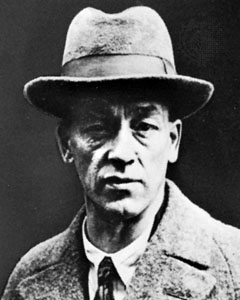On 15 March, 2016, the Centre for Scottish and Celtic Studies welcomed Rob Maslen to discuss ‘”The Political Imagination”: Irish Fantasy Writers and the Easter Rising.’ Below is this listener’s brief summary of the lecture.
Rob Maslen began by explaining that the aim of this paper was to explore the concept of fantasy writing as a form of history. He noted that during the 20th century, there was a remarkable increase in writers who began to use fantasy and the impossible to respond to current events and change. He chose the Easter Rising as a case study to explore this concept primarily because there were two writers who were present at the event and wrote about their own personal experiences from their opposing political perspectives. These two writers are James Stephens, who was a nationalist, and Lord Dunsany, a unionist. By comparing the writings of each, one can get an idea of the socio-political complexity of Ireland during this period.

James Stephens was a nationalist who was close friends with one of the leaders of the rising, Thomas MacDonagh. His work, “The Insurrection in Dublin” (1916) reports events as he saw them during the week of turbulence. He describes Dublin as it was cut off from the rest of the world, which left them isolated, without reliable information or food. The people of Dublin were then left with many rumours about how the insurrection had started, each of which Stephens describes in his story. His personal belief was that the insurrection was caused by the lack of imagination at its best, a lack of “intelligent kindness,” especially on the part of British politicians.
In “The Insurrection in Dublin,” Stephens sought to portray the mindset of all who experienced the Easter Rising: of the supporters of the uprising, of those who opposed it, and of those who were not sure how they felt about it. By presenting all of these perspectives, he brought all of them together in a new kind of imaginative unity, so that his readers could see each other’s point of view. In this book, he provides character sketches that demonstrate the shifting sympathies of bystanders and the overall fragmentation of the city. As the narrative goes on, the mood of Dublin changes and becomes more sympathetic to the Volunteers’ cause, which eventually becomes a feeling of national pride. In the last few chapters, Stephens describes the victims of hunger, who blamed the Volunteers for depriving them of food. At the end of the week, he describes the fear caused in the Irish people by the police, who he viewed as the willing tools of the British Empire and represented what caused the war in the first place. The story of the Insurrection opens out to transform the local into the national, much in the way that it does in his previous work, “The Crock of Gold” (1912). Maslen drew many parallels between Stephens’s two novels, but ended by saying that at the end of “The Insurrection in Dublin,” Stephens appeared hopeful that the Easter Uprising could result in a unified Ireland, something as fantastic and optimistic as The Happy March, the final chapter of the “The Crock of Gold,” in which the Thin Woman and the fairy-folk of the Shee freed the Philosopher and other imprisoned men and women through dance and song.

Edward Plunkett, who wrote under the name of Lord Dunsany, was a unionist and a captain of the British army at the time of the uprising. In the course of reporting for duty, Dunsany traveled directly into the path of the Volunteers. They wounded his chauffeur and hit Dunsany in the face with a ricochetted bullet. The Volunteers took him prisoner, apologized for shooting him, and then took him to a hospital.
His time behind enemy lines appears to have inspired the perspective of an aristocrat in a similar position in “The Curse of the Wise Woman” (1933). Dunsany’s views on the cultural and political complexity of the situation are conveyed through a recurring theme of one culture overwhelming another in Dunsany’s subsequent works, especially “The Prayer of the Men of Daleswood” (1918) and “The King of Elfland’s Daughter” (1924). In the latter, the elders of a village decided that the quickest way to be remembered in history was through magic and urged their lord to wed his son to the daughter of the King of Elfland. After many years of negotiations, the King of Elfland extended the boundaries of his country to include the village so that he does not lose his daughter to a mortal husband and so that his daughter does not pine for the mortal world. Maslen pointed out that while researchers typically compare this to the incorporation of Ireland into the British Empire, one could also see this as the mortal village being trapped with hostile strangers who are also their friends and relatives, much like Dunsany’s experience in Dublin. After the mortal lord’s son loses his elf princess, he wanders across the land looking for the borders of Elfland. Once he does find the magical land again, a familial reunion takes place; a happy but fantastic solution to the strange splits and rifts between their world.
By comparing the various works of these two writers, one begins to gain a better understanding of the political and religious complexities that surrounded Ireland during this period. Both Stephens and Dunsany had friends and relatives on either side of the conflict. Both shared a political imagination and, through their stories, sought to share it with the Irish people as a whole and to convey their perspectives to a global audience.
Summary by Megan Kasten (PhD Researcher)
Our seminar series concludes on 22 March 2016 with Alan MacQuarrie (Glasgow), who will discuss ‘Roderick MacLean of Iona (d. 1553): a renaissance Humanist from the Western Isles.’ This seminar will take place in the Lecture Theatre of the Sir Alexander Stone Building at 5.30 pm, preceded by tea and coffee from 5.00 pm.

